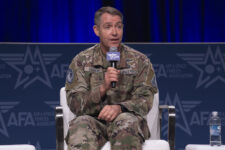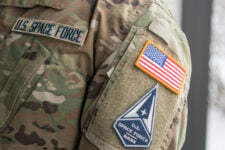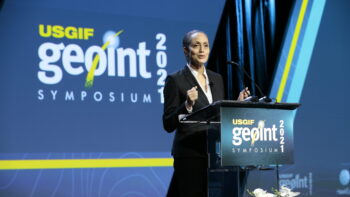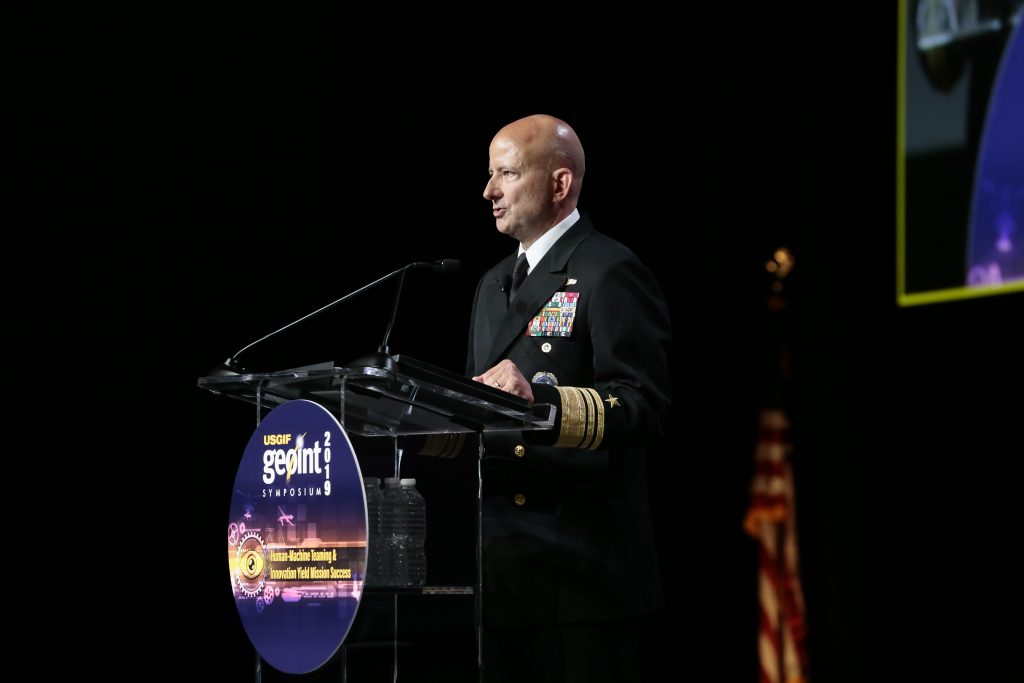
Vice Adm. Bob Sharp, director of the National Geospatial-Intelligence Agency (NGA)
WASHINGTON: Nearly two years after authority to procure commercial satellite imagery for military and intelligence uses passed from the National Geospatial-Intelligence Agency (NGA) to the National Reconnaissance Office (NRO), that process continues to suffer growing pains, according to industry, former officials and government insiders.
Despite best efforts by NRO and NGA to work out and articulate their respective roles, a number of sources tell me that the lines between the two agencies’ responsibilities remain fuzzy, and that the process of contracting commercial capabilities is slowing down. There also are indications that ‘cracks and seams’ may be developing between the two in setting priorities and interpreting requirements for commercial providers, industry sources say. Finally, many in the GEOINT community harbor lingering fears that NRO can’t serve as an honest broker for commercial companies, given its central role in developing, building and operating intelligence, surveillance and reconnaissance (ISR) satellites.
Blurred Lines
“Governments are not monoliths,” said one industry representative noting that NGA and NRO “have significantly overlapping Venn diagrams,” and they are still trying to “sort that through.” He added, “It’s not a nice clean line.”
This question of where NGA’s responsibility stops and NRO’s takes over is not a new phenomena, according to several former officials. “NGA-NRO relations have never been good,” says one former NRO official. “I think it centers around where the roles of one stops and the other starts.”
Many in the GEOINT community say the blurry borderline between the two is being further exacerbated by the shift in responsibilities for procuring commercial satellite imagery. Before the shift, these sources say, NGA had crystal clear authority in obtaining all commercial geospatial intelligence-related imagery and data to augment that provided by the NRO’s highly classified space systems and other data sources from other intelligence agencies. Now, the waters are muddied, with NGA retaining authority over acquisition of all other imagery sources and the responsibility to ensure that everything fits together; whereas NRO holds the reins for buying commercial satellite imagery and creating a new military-intelligence satellite imagery architecture.
In August last year, NRO finally assumed control of NGA’s long-running relationship with commercial company DigitalGlobe — and for managing the contracting process to procure high-resolution, electro-optical imagery for the next-generation of the ongoing EnhancedView satellite constellation. The original EnhancedView contract was signed in 2010 with DigitalGlobe and the now defunct GeoEye. DigitalGlobe long has been one of two large companies (along with Airbus) dominating the global market for commercial satellite imagery.
Senior NGA and NRO officials, for their part, insist that the delineation of authority and responsibility under the transition is not only perfectly clear, but simple.
Vice Adm. Bob Sharp, new-ish NGA director, told reporters at GEOINT 2019 in San Antonio last Monday: “NRO brokers pixels for us. We just changed the business model for how we interact with the companies in acquiring those pixels.” He added, “We help broker requirements, and they help design, field and operate.”
Troy Meink, director of geospatial intelligence for NRO, echoed: “We are the procurement arm for NGA for satellite imagery.”
David Gauthier, director of NGA’s new Commercial & Business Operations office, and Peter Muend, director of NRO’s new Commercial Systems Program Office — told me in a joint interview last Wednesday in San Antonio that two agencies are on the same wavelength internally about their respective roles.
“We are the principal acquirer of commercial imagery,” said Muend, “but if you climb the value chain to data analytic services, that is and remains NGA’s responsibility.”
“On the NGA side, our strategic focus is moving toward analytic services for the commercial market, and other data products, not focusing on acquiring the imagery from overhead,”explained Gauthier, He added: “I think there’s no better partner to optimize what pixels you get from overhead than the NRO.” He was careful to specify that NGA’s interest is in “data products and services” and “geolocation data, not imagery.” Geolocation data, based on radio frequency signals or GPS coordinates for example, is information that can be used to pinpoint an object’s physical location.
Gauthier and Muend, who seem as comfortable together as an old married couple, stressed that they personally, and their respective agencies, are working closely together to ensure that the transition process continues seamlessly and apace.
Gauthier said that rather than simply turn over the requirements for commercial imagery that NGA itself has validated, “We go to NRO from the very beginning and work on those evaluations together. NRO helps us with the technical evaluations, and then we look at mission utility across our user needs. As those requirements solidify, NRO would procure that imagery as per the agreement.” Muend piped in: “It’s a real team effort.”
NRO in September 2018 issued a contract for the EnhancedView follow-on to DigitalGlobe, that now (confusingly) goes by the new corporate moniker Maxar Technologies. Rather than a firm long-term buy, it was a $300 million one-year contract for NRO to access data from Maxar’s WorldView and GeoEye satellites, with an option for another year’s worth of imagery for a total of $600 million in potential work. Maxar in November 2018 won a contract extension that added a potential $300 million to the deal (bringing the potential total up to $900 million), via options for NRO to access data from its new WorldView Legion constellation (set to begin launching in 2021) through 2023.
And, as I reported last Tuesday, NRO on May 31 granted new ‘study contracts’ to relative newcomers BlackSky Global and Planet as part of the EnhancedView Follow On effort. At the same time, it also issued another ‘study contract’ to Maxar to review it latest capabilities relevant to NRO plans. According to industry sources, the next-generation satellite system will not just require high-resolution optics, but also a higher revisit rate to give military and IC users more persistent coverage. NRO expects to award procurement contracts within the next six to 12 months.
This sets up real competition for commercial high-resolution electro-optical imagery contracts, starting in 2020, that one industry representative said could make or break the companies involved. “The fact that they made an award today to not only DigitalGlobe, but these two young upstarts, is kind of Earth-shattering,” the source said.
Muend and other NRO officials at GEOINT 2019, however, explained that demand for satellite imagery among military and IC users is expected to skyrocket; thus it’s likely there will be room for more than one provider.
Muend said that all three companies are now in the running for the EnhancedView Follow-On program that includes an “expanded set of requirements.” He added, “I presume all of them will be part of that process, especially DigitalGlobe, and be part of that capability down the line. Whether or not it’s via a contract called Enhanced View, they’ll certainly all contribute.”
At the same time NGA is still involved in the EnhancedView Follow On program and process. Sharp told reporters in San Antonio: “I don’t want to get into a classified discussion on this, but there are NRO parts of that and NGA parts of that. If you think about the important relationship that we have with NRO, we are the users. Our interaction with NRO is integrated by design and necessity.”
Further, NGA continues to manage other contracts and relationships with commercial companies that it had initiated prior to the 2018 transition of the EnhancedView program. For example, NGA in April exercised a contract option (worth $5.9 million) to continue its access to Planet’s daily imagery and the company’s automated data processing system that NGA is using to augment its own capabilities.
Muend explained: “There are a number of — I don’t want to call them legacy contracts — contracts that existed prior to that changeover that we’re growing into. The transition of EnhancedView was a big part of that, and really the first one we took on. But we’re all learning as we are going, and we’re growing into those roles.”
Reinventing the wheel?
One question, however, is why does NRO feel the need to ‘study’ the capabilities of companies that already have been under contract to NGA? After all, NGA remains the agency responsible for setting requirements for commercial imagery acquisition writ large, i.e. not just from satellites but also from aircraft and drones.
NGA’s first contract with Planet was in 2016, and it has since signed several more. BlackSky has been working with NGA for almost two years. And as detailed above, DigitalGlobe/Maxar have been providing NGA imagery for nigh on 20 years.

Troy Meink, new chief of NRO’s Geospatial Intelligence Directorate
Meink explained that the new EnhancedView Follow On is “the first step.” He added: “We call them study contracts, but these are major efforts to start working with the commercial vendors that we traditional have not — to figure out what they can do, how they can deliver product, and whether they can best meet the requirements that are given to us by the larger user community.”
But … isn’t it NGA’s job to figure out that stuff before NRO gets involved? As one insider noted, the move by NRO to ‘study’ capabilities rather than simply open a competition seems to suggest that NRO does not trust NGA’s own vetting process.
- NRO decided on its own that the companies under consideration for the follow-on to EnhancedView may not be ready for prime time (since NGA already had decided they were offering capabilities ready for purchase); or,
- NGA and NRO changed the baseline requirements for the program between the September 2018 contract to DigitalGlobe and January 2019 when NRO put out RFIs to find potential participants in the EnhancedView Follow On.
In an official joint response to my questions, NGA and NRO said: “The requirements process began well before 2018 and is independent of any contracts. It is led by the GEOINT Functional Manager (NGA) and includes data gathering of mission needs across the entire NSG. Then NGA and NRO work
together to determine how best to satisfy the requirements for imagery in terms of national and/or commercial systems, phenomenology, accuracy, etc. Given limited resources, NGA then has to adjudicate priorities.”
NRO’s rationale for extending its review process for EnhancedView may be because of its wider focus on commercial satellite imagery as part of an overarching US intelligence-gathering satellite architecture, the former NRO official said. “The driver for putting the contracts in NRO as seen by the Hill, the ODNI and NRO leadership is the need to provide a combined imagery architecture,” the source said. “I think that is why NRO would issue its own RFIs and study contracts. It’s one thing for NGA to say that various commercial systems meet certain NGA requirements, and another thing to say that some postulated architecture combines to meet all requirements.”
A Little (Troubled) History
It might be useful to look back at the history of interagency relations that led up to the current state of play. NRO for decades was the sole provider of exquisite high-resolution imagery to the military and the IC, and damned glad to be so. Even after US policy changed in 2003 and NGA began acquiring commercial imagery, NRO treated the commercial industry as a threat — while at the same time disparaging commercial capability as nowhere near as important as its own.
NRO’s change of heart started under former and long-serving NRO Director Betty Sapp, who according to insiders saw the writing on the wall regarding both demand for imagery-based intelligence outstripping need, and the fact that NRO alone was not going to be able to meet that growing demand.
The former NRO official said: “NRO leaders embraced commercial from an early time, but the troops most certainly didn’t.”
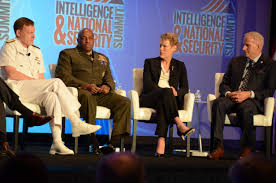
Former NRO Director Betty Sapp center right; former NGA Director Robert Cardillo far right
One former US government official with a long pedigree in satellite-based intelligence said that the 2017 decision by the Trump Administration (led by former Director of National Intelligence James Clapper) to shift commercial imagery acquisition to NRO was essentially a coup by Sapp. “The transfer of ownership would have been described in business parlance as a ‘hostile takeover.’ In government-speak, it was a ‘management decision to better align roles and responsibilities.’ … Betty was singularly responsible for forcing the move and (former NGA Director Robert Cardillo) could not stop her — Betty is an incredibly skilled bureaucratic player.”
Adding that “there is still bad blood from that,” the source explained that “NGA does not trust NRO to do this right (and with some long and deep-seated historical perspective). I do think NRO wants to do it right, but they are new to the game.”
Indeed, there are indications that some amount of friction between NRO and NGA remains, at least regarding priorities. While both agencies clearly believe it it critical to not have a break down in current service to imagery users, it is also clear that NRO is focused right now on the EnhancedView Follow On. Thus, moving to obtain non-electro-optical and smallsat-based lower-resolution imagery, as well as high-revisit imagery, from commercial vendors seems to be a second priority, some sources said.
According to Meink, the next step after EnhancedView Follow On is “to look at other contractors in other phenomenologies — radar and others — that are just in the incubation period in the commercial world … to figure out how we can be flexible enough to work with them and procure capability without upsetting what they’re trying to do in the commercial world.” He said that requests for information RFIs (the first step in the contracting process) for other sorts of imagery providers will be forthcoming sometime in the next six to 12 months.
This means that for at least the next year at a minimum, NRO is not looking to acquire the wider set of capabilities, including synthetic aperture radar (SAR) data that NGA has been increasingly interested in utilizing.
NGA in 2009 began buying commercial SAR imagery from three European companies, as there were no US companies in the market (due to US policy that barred commercial SAR sales, in large part because NRO’s own SAR satellites were super secret.) Those contracts have, however, expired according to NGA and NRO. NGA currently has exploratory agreements with US startups Ursa Space Systems that is positioning itself as a middleman between SAR satellite operators and customers, and Capella Space that intends to build a 36-satellite constellation that provides high resolution (0.5 meter) SAR data with high revisit rates.
Muend, however, opined that US commercial companies planning SAR satellites are still in their infancies — as is the government’s ability to ingest commercial SAR data. “Certainly we’re at a less mature state in … the executive branch side in terms of being able to consume that, and the industry being able to provide that.” He add that “if and when [SAR data is] available and it meets our needs, absolutely we’ll be there to purchase it.”
That said, the NRO and NGA spokespeople said that both agencies believe that a mix of capabilities is needed, noting that “while each collection requirement is unique, in general, the hybrid approach satisfies the greatest range of requirements.”
Sharp, in his remarks last Monday, conceded that there are issues still being worked out between NGA and NRO. He said: “We’ll continue to look at how we evolve really being able to tap into commercial capacity and sources out there.” He stressed however that his primary goal — making sure that NGA’s customer needs continue to be fulfilled — is being met, and that “right now I think it’s really working for us.”
Fox in the Henhouse?
Furthermore, more than one GEOINT professional I spoke with raised the question of whether NRO now has an internal conflict of interest, given that investing in commercial capability could be seen as competing with its in-house expertise and development projects for funding.
One industry source involved opined that “antibodies to commercial imagery definitely continue to exist” within NRO, but said that the pressure and momentum from Congress and the Trump Administration are beating them back.
In his presentation at GEOINT 2019, Meink was definitive about NRO’s commitment to commercial resourcing. “To be quite honest most of our space systems are not the leading edge technologies,” he said. “We’ve not kept up in many cases with the commercial environment.”
Others are not so sure. Several industry officials expressed the fear that NRO may not only be dragging its feet via the vetting process out of concern about competition, but also possibly because it is seeking to learn all it can about commercial capabilities in order to migrate those capabilities into NRO’s own development programs.
Again, looking at historical precedents helps to see why such fears exist. In 2009, the Obama Administration forced defense and national security space contractors to spin off their Scientific, Engineering and Technical Analysis Services (SETA) units that advised DoD and the military services regarding new programs. SETA contractors worked side-by-side with government acquisition officials to help with the development, production and management of programs. In instances where the SETA contractors were employed by a company that also manufactured equipment, SETA employees were separated from the rest of their firm by firewalls. Nonetheless, the Obama Administration (and Congress) decided there simply was too much room for conflict of interest to arise if the SETA practice was allowed to continue.
NRO is now in the business of developing, producing and managing high-dollar, highly exquisite, and vitally important national security remote sensing satellite constellations. It is also in the position of working with NGA to shape requirements, and then translate those requirements into acquisition programs, for commercial remote sensing imagery for national security uses. Obviously, there is a parallel with the SETA situation regarding potential conflict of interest.
This is not to suggest that NRO leaders or personnel have either overt or covert goals to push commercial providers out of the national security marketplace, or to steal their intellectual property. Indeed, the creation of Muend’s organization shows that the spy agency is concerned about providing a clear barrier between its own programs and its commercial acquisition mission. Muend, for his part, strongly refuted any talk of an NRO conflict of interest, whether regarding SAR or any other kind of imagery. “I don’t think there is.”
But, it is understandable that some in industry might fret — especially when thinking about what happens if NRO gets a major budget cut and has to decide between its own classified imagery programs and buying unclassified commercial imagery.
Slowing Progress?
Finally, there is widespread industry concern that the progress the US government was making in integrating commercial remote sensing data with its classified content has been significantly retarded by the transition from, NGA to NRO. One industry source said the transition has put everything back by at least two years, if not more. While not a terrible delay by DoD time, in commercial industry time a two-year delay is ages. And in startup time, it could be fatal given the pressure for return on venture capital investment. One market analyst explained that while venture capitalists are happy to take risks with throwing large amounts of money at startups, they also are impatient and won’t wait long to recoup their money with (hopefully massive) dividends and are quick to simply cut their losses.
The slowing pace of change also threatens to close the window in which the US government can use the boom in the domestic commercial remote sensing market to rapidly improve its military and IC capabilities vice those of its potential adversaries, some sources worry. That is because the market is global, and US commercial firms as well as their foreign competitors are proliferating technologies and capabilities on the world stage.
“They (NRO) are very slow off the block,” said the former US government official. “Part of this comes from their role versus NGA. As the GEOINT manager, NGA could set its own requirements and therefore decide if any specific player met them. NRO is handed a set of requirements that it does not own, so it has to be more bureaucratic than NGA about how it evaluates capability.”
The process of transition obviously has really just begun, so acquisition speed — as well as interagency coordination — could very well improve. And, laudably, NRO and NGA are jointly in the midst of a massive outreach program to industry that may help settle the nervous zeitgeist.
Congress is also keeping an eyeball on the issue. While applauding the transition of authority to NRO in its markup of the fiscal 2020 National Defense Authorization Act (NDAA), the House Armed Services strategic forces subcommittee would require the agency directors to report their progress by Oct. 1, and the language stresses the need for working with multiple vendors. While the HASC provision has a long ways to go through the congressional approval process, it is clear at least one side of Capitol Hill will be monitoring the process.
Watch this space.
‘Changes’ expected in ISR satellite operations to sort NGA, Space Force roles: White House official
“In the end, what we’re really going to have to figure out here is: what needs to change? Is it policies? Is it authorities? Is it processes? Is it funding? Is it purely just advocacy and communication?” said National Space Council Director Chirag Parikh.











